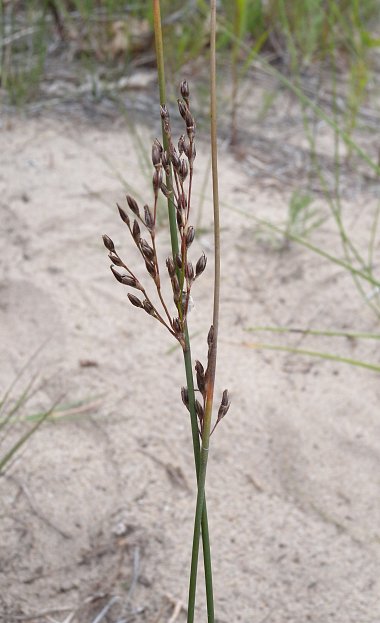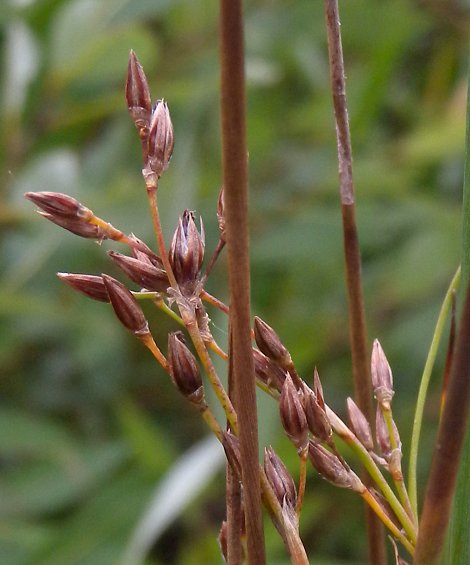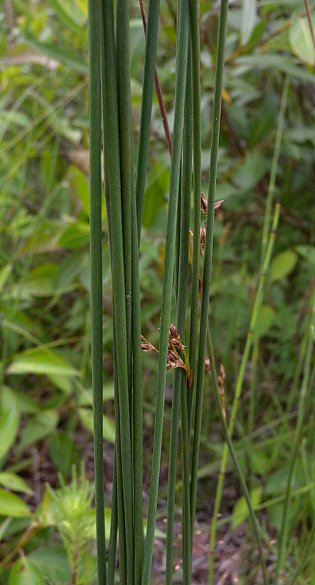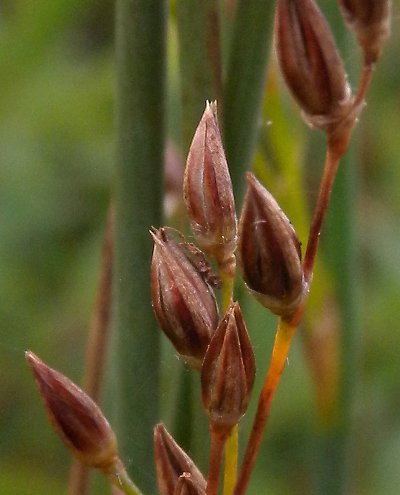
The petals and sepals are about the same length and lanceolate in shape; they are green-veined in the middle (later becoming brown), while their margins are membranous. The elongated anthers are pale yellow; they are about twice as long as their filaments. Underneath the spikelets, there are usually a few chaffy scales that are lanceolate to ovate in shape. The blooming period occurs from late spring to early summer, lasting about 1-2 weeks. The flowers of the spikelets are cross-pollinated by the wind. Afterwards, these flowers are replaced by seed capsules that are about the same length or slightly longer than the sepals and petals; these capsules are lanceoloid in shape and become brown at maturity. The capsules divide into 3 parts to release their tiny seeds later during the summer. Mature seeds are 0.5–1 mm. in length, brown, ellipsoid and somewhat compressed in shape; they are small and light enough to be blown about by the wind. The shallow root system is long-rhizomatous and fibrous. Colonies of clonal plants often develop from the rhizomes. Sometimes these clonal plants form lines along the rhizomes.

Cultivation: The preference is full sun, wet to moist conditions (including shallow water), and sandy soil. Plants can be propagated by division of the long rhizomes. Dry conditions and shade are poorly tolerated. However, this plant is very winter-hardy.
Range & Habitat: The native Baltic Rush is largely restricted to NE Illinois, where it is uncommon (see Distribution Map). Outside of the state, this rush has a large range that extends from the Atlantic coast (including New England & Canada) to the Pacific coast. Some varieties or subspecies of this rush also occur in Europe and Mexico. In Illinois, habitats include sandy pannes along Lake Michigan, borders of sandy ponds, interdunal swales along Lake Michigan, sand bars and gravel bars along rivers, and sandy ditches along railroads. In Illinois, the Baltic Rush is usually found in high quality natural areas. Outside of the state, this rush also occurs in brackish marshes and alkaline wetlands.

Faunal Associations: Insects that feed on Baltic Rush (Juncus arcticus balticus) and other rushes (Juncus spp.) include such species as Spharagemon collare (Mottled Sand Grasshopper), the aquatic leaf beetle Plateumaris pusilla, stem-boring larvae of some Cerodontha spp. (Agromyzid flies), the seed bugs Cymodema breviceps and Cymus angustatus, the aphids Rhopalosiphum nymphaeae and Prociphilus corrugatans, and Livia maculipennis (Rush Psyllid). The larvae of such moths as Archanara subflava (Yellow Sedge Borer), Bactra verutana (Javelin Moth), and Chilo forbesellus (Crambid moth sp.) also feed on rushes (see Brust et al., 2008; Clark et al., 2004; Spencer & Steyskal, 1986; Hoffman, 1996; Blackman & Eastop, 2013; Felt, 1917; Harms & Grodowitz, 2009; Miller, 1987). Some vertebrate animals feed on Baltic Rush and other rushes. The seed capsules are eaten by such waterfowl as the Green-winged Teal, Blue-winged Teal, Mallard, Northern Pintail, Gadwall, American Wigeon, Northern Shoveler, Redhead, Ruddy Duck, American Coot, and Canada Goose (Hauser, 2005). Muskrats feed on the rhizomes and bases of these plants, while hoofed mammalian herbivores eat the coarse foliage sparingly. Dense stands of Baltic Rush and similar plants provide nesting habitat for ducks and other wetland birds; the Yellow Rail uses the stems of Baltic Rush in the construction of its nests. Dense stands of Baltic Rush and similar plants provide protective cover in wetlands for small birds and other kinds of wildlife. (Hauser, 2005).

Photographic Location: Near a sandy pond along Lake Michigan at Illinois Beach State Park in NE Illinois.
Comments: Among rushes (Juncus spp.), Baltic Rush is fairly easy to identify because its panicle of spikelets appears to be produced laterally near the middle of its stem. In reality, this inflorescence is produced from the apex of the stem, while a stem-like spathe rises above it. The only other rush in Illinois with this characteristic is Soft Rush (Juncus effusus). This latter rush can be distinguished from Baltic Rush by its densely clustered stems, which have a rosette-like appearance. In addition, the spikelets of Soft Rush are less elongated in shape than those of Baltic Rush. The Baltic Rush has an unstable taxonomic history that continues to the present time. For example, the ITIS refers to this rush as Juncus balticus littoralis, the USDA refers to this rush as Juncus arcticus littoralis, and eFloras refers to this rush as Juncus arcticus balticus. The last scientific name has been adopted here. Additional varieties or subspecies of this rush exist, but they do not occur in Illinois. Another common name of this species is Lake Shore Rush.